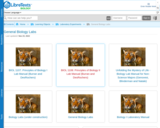
This is a link to a collection of the General Biology lab manuals available on LibreTexts.
- Subject:
- Anthropology
- Social Science
- Material Type:
- Textbook
- Provider:
- LibreTexts
- Author:
- Anonyous
- Date Added:
- 12/13/2022

This is a link to a collection of the General Biology lab manuals available on LibreTexts.

The topic for Fall 2006 is short film and radio plays. This course investigates current trends and topics in German literary, theater, film, television, radio, and other media arts productions. Students analyze media texts in the context of their production, reception, and distribution as well as the public debates initiated by these works. The topic for Fall 2006 is German Short Film, a popular format that represents most recent trends in film production, and German Radio Art, a striving genre that includes experimental radio plays, sound art, and audio installations. Special attention will be given to the representation of German minorities, contrasted by their own artistic expressions reflecting changes in identity and a new political voice. Students have the opportunity to discuss course topics with a writer, filmmaker, and/or media artist from Germany. The course is taught in German.

Prepares students for working and living in German-speaking countries. Focus on current political, social, and cultural issues, using newspapers, journals, TV, radio broadcasts, and Web sources from Germany, Austria, and Switzerland. Emphasis on speaking, writing, and reading skills for professional contexts. Activities include: oral presentations, group discussions, guest lectures, and interviews with German speakers. No listeners.

This lesson plan was created by Jennifer Pritchett as part of the 2020 Nebraska CTE-Beginning Teachers Institute. The attached lesson plan is designed for students in grades 7-12 as a introduction to a service learning project. This lesson plan can also be used in classes such as Sociology, Introduction to Education, Ethics, Leadership, etc. Students will learn the meanings of values and rank their top 5 values in a hands on or virtual format. The culminating project is collaboration on a Google Slides presentation with the rest of the class.

Short Description:
The book introduces readers to philanthropic ideas, concepts, and influencers in American history at an introductory, undergraduate level.
Long Description:
This book was created as a reader for the P105: Giving and Volunteering in America course in the IU Lilly Family School of Philanthropy at IUPUI. The course introduces non-major undergraduate students to philanthropic ideas, concepts, and influencers in American history at an introductory level. It is mostly built using primary sources and original documents from early thinkers about how people help one another and build communities. It also includes biographical information and descriptions of notable people and organizations as well as some contemporary materials to provide context. This book includes only items that are openly available online, either in their entirety or as links. Instructors are encouraged to supplement it with additional instructional materials and discussions. It is important to note that many of the materials are “of their time,” and may use words or language in ways that are different than the modern time. These should be considered in their context and, again, instructors are invited to draw in materials the provide additional perspectives on the people and periods represented in this text.
Word Count: 43121
(Note: This resource's metadata has been created automatically by reformatting and/or combining the information that the author initially provided as part of a bulk import process.)

This course examines contemporary and historical cultural production on and from Africa across a range of registers, including literary, musical and visual arts, material culture, and science and technology. It employs key theoretical concepts from anthropology and social theory to analyze these forms and phenomena. It also uses case studies to consider how Africa articulates its place in, and relationship to, the world through creative practices. Discussion topics are largely drawn from Francophone and sub-Saharan Africa, but also from throughout the continent and the African diaspora.
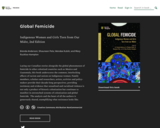
Indigenous Women and Girls Torn from Our Midst, 2nd Edition
Short Description:
Laying our Canadian stories alongside the global phenomenon of femicide in other colonized countries such as Mexico and Guatemala, this book underscores the common, interlocking effects of racism and sexism on Indigenous women. Family members, scholars and researchers, artists, activists and policy-makers provide their decade-long perspectives, providing testimony and evidence that sexualized and racialized violence is not only a product of historic colonization but continues to manifest in entrenched systems of colonization and global femicide. The analysis and the heart of all the authors is generously shared, exemplifying what resistance looks like.
Long Description:
Global Femicide: Indigenous Women and Girls Torn from our Midst brings Canadian, Mexican and Guatemalan stories together to show that the interlocking systems of sexualized and racialized violence is not only a product of historic colonization but continues to be entrenched as deliberate systems of colonization and global femicide. Using reflections from Torn from our Midst: Voices of Grief, Healing and Action from the 2008 MMIW Conference, this book is uniquely situated to provide a decades-long retrospective on what, if anything has changed since the time of that conference. Roadblocks and successes are found in the chapters written by family members, scholars and researchers, artists, global activists and Canadian policy-makers.
This book is designed to be readable and approachable, taking an Indigenous feminist approach of including personal stories of family members as well as critical analyses of history, governmental policies, intimate partner violence and health, and intergenerational art activism. Issues around governmental manipulation in the Canadian Indian Act, Mexican families’ resistance to neo-liberal economics as it pertains to the vulnerability of women workers in maquiladoras as well as the rampant environmental crisis, and the devastation wreaked by complicit governments and police forces in Guatemala all have bearing on the specific vulnerability of Indigenous women. Book sections provide specific recommendations, such as the chapters on pedagogical and administrative transformation at the university level. The book is driven by the underlying question of how we can best prepare and support young adults in work that redresses structural colonialism and violence against women. Each chapter serves as a call to all global citizens to engage in the work of decolonization, reconciliation (or “setting things right” as Maria Campbell teaches us) and justice. The analysis and the heart of all the authors is generously shared, exemplifying what resistance looks like.
Word Count: 83097
ISBN: 978-0-7731-0762-5
(Note: This resource's metadata has been created automatically by reformatting and/or combining the information that the author initially provided as part of a bulk import process.)
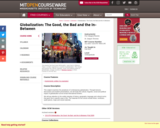
This subject examines the paradoxes of contemporary globalization. Through lectures, discussions and student presentations, we will study the cultural, linguistic, social and political impact of globalization across broad international borders.
We will pay attention to the subtle interplay of history, geography, language and cultural norms that gave rise to specific ways of life. The materials for the course include fiction, nonfiction, audio pieces, maps and visual materials.

This subject examines the paradoxes of contemporary globalization. Through lectures, discussions and student presentations, we will study the cultural, linguistic, social and political impact of globalization across broad international borders.
We will pay attention to the subtle interplay of history, geography, language and cultural norms that gave rise to specific ways of life. The materials for the course include fiction, nonfiction, audio pieces, maps and visual materials.

In this module, students explore the concept of personal identity formation and transformation in both historical and modern-day societies. The module begins with an overview of what “identity” means and how it can mean different things to different people. In Unit 1, students read first-person narratives that focus on various social identifiers—from race to gender to socioeconomic status—as they begin to frame their understanding of what identity means. Students read informational text, identifying central ideas, analyzing how an author develops his or her claims, and identifying how the sections of the text interact to form those ideas.
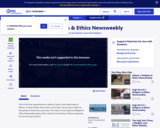
In this video segment from Religion & Ethics Newsweekly, meet an American Muslim as he prepares for Hajj, the pilgrimage to the holy city of Mecca that commemorates the Abrahamic roots of Islam.
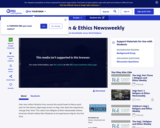
Performed with over two million other Muslims, the rites of Hajj, the required pilgrimage to Mecca, have a profound personal impact on each pilgrim. In this video from Religion & Ethics Newsweekly, a Muslim from America experiences Hajj for the first time.

Students learn about an American Muslim's impressions of his first pilgrimage to Mecca in this video segment from Religion & Ethics Newsweekly.
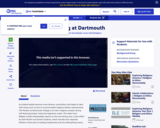
A dining hall at Dartmouth College accommodates the religious dietary requirements of Muslims, Jews and Hindus as explained in this video from Religion & Ethics Newsweekly.

Jhoshue veras

This class explores the political and aesthetic foundations of hip hop. Students trace the musical, corporeal, visual, spoken word, and literary manifestations of hip hop over its 30 year presence in the American cultural imagery. Students also investigate specific black cultural practices that have given rise to its various idioms. Students create material culture related to each thematic section of the course. Scheduled work in performance studio helps students understand how hip hop is created and assessed.
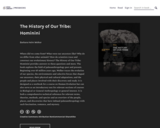
Short Description:
Return to milneopentextbooks.org to download PDF and other versions of this textNewParaWhere did we come from? What were our ancestors like? Why do we differ from other animals? How do scientists trace and construct our evolutionary history? The History of Our Tribe: Hominini provides answers to these questions and more. The book explores the field of paleoanthropology past and present. Beginning over 65 million years ago, Welker traces the evolution of our species, the environments and selective forces that shaped our ancestors, their physical and cultural adaptations, and the people and places involved with their discovery and study. It is designed as a textbook for a course on Human Evolution but can also serve as an introductory text for relevant sections of courses in Biological or General Anthropology or general interest. It is both a comprehensive technical reference for relevant terms, theories, methods, and species and an overview of the people, places, and discoveries that have imbued paleoanthropology with such fascination, romance, and mystery.
Long Description:
Where did we come from? What were our ancestors like? Why do we differ from other animals? How do scientists trace and construct our evolutionary history? The History of Our Tribe: Hominini provides answers to these questions and more. The book explores the field of paleoanthropology past and present. Beginning over 65 million years ago, Welker traces the evolution of our species, the environments and selective forces that shaped our ancestors, their physical and cultural adaptations, and the people and places involved with their discovery and study. It is designed as a textbook for a course on Human Evolution but can also serve as an introductory text for relevant sections of courses in Biological or General Anthropology or general interest. It is both a comprehensive technical reference for relevant terms, theories, methods, and species and an overview of the people, places, and discoveries that have imbued paleoanthropology with such fascination, romance, and mystery.
Word Count: 59080
ISBN: 978-1-942341-40-6
(Note: This resource's metadata has been created automatically by reformatting and/or combining the information that the author initially provided as part of a bulk import process.)
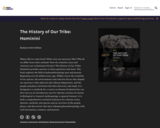
Short Description:
Where did we come from? What were our ancestors like? Why do we differ from other animals? How do scientists trace and construct our evolutionary history? The History of Our Tribe: Hominini provides answers to these questions and more. The book explores the field of paleoanthropology past and present. Beginning over 65 million years ago, Welker traces the evolution of our species, the environments and selective forces that shaped our ancestors, their physical and cultural adaptations, and the people and places involved with their discovery and study. It is designed as a textbook for a course on Human Evolution but can also serve as an introductory text for relevant sections of courses in Biological or General Anthropology or general interest. It is both a comprehensive technical reference for relevant terms, theories, methods, and species and an overview of the people, places, and discoveries that have imbued paleoanthropology with such fascination, romance, and mystery.
Word Count: 59325
ISBN: 978-1-942341-40-6
(Note: This resource's metadata has been created automatically as part of a bulk import process by reformatting and/or combining the information that the author initially provided. As a result, there may be errors in formatting.)
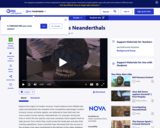
This video segment, adapted from NOVA, explores reasons why Homo sapiens had an advantage over Neanderthals in the pursuit of territory and natural resources.

This course introduces diverse meanings and uses of the concept of culture with historical and contemporary examples from scholarship and popular media around the globe. It includes first-hand observations, synthesized histories and ethnographies, quantitative representations, and visual and fictionalized accounts of human experiences. Students conduct empirical research on cultural differences through the systematic observation of human interaction, employ methods of interpretative analysis, and practice convincing others of the accuracy of their findings.